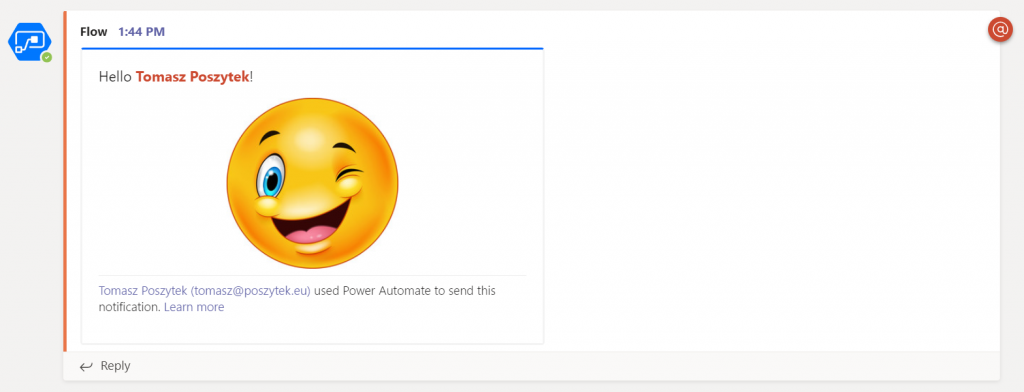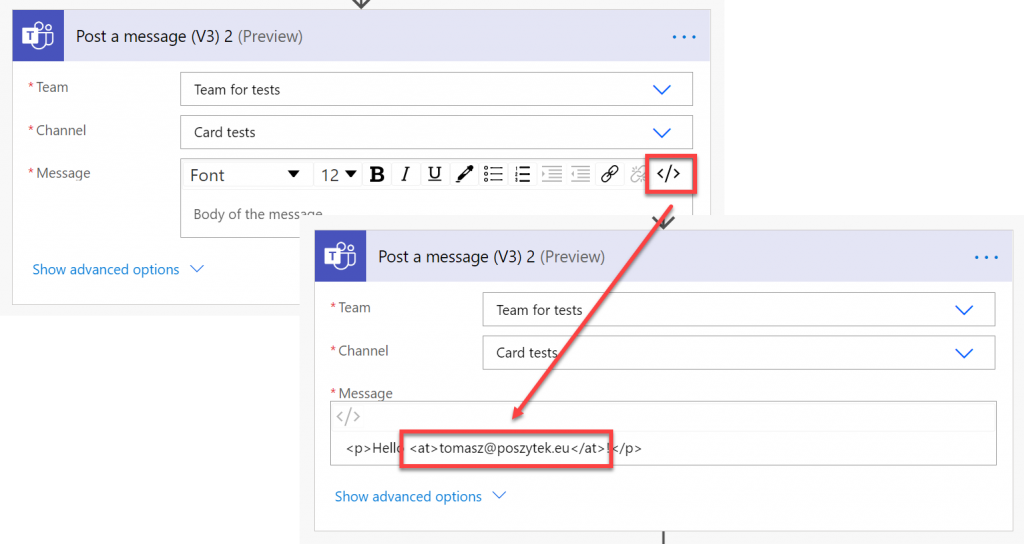
Mentioning in Microsoft Teams via Power Automate
Table of contents:
This topic has been continuously raised by multiple people I’ve been talking to. How can a user be mentioned in Microsoft Teams when a message is sent from Power Automate? This issue seemed to never been really possible for us, Power Users, until couple days ago Microsoft released new action in Microsoft Teams set in Power Automate called: “Get @mention token for a user”. It’s even cooler, because it works with Adaptive Cards too!
See it in action!
How to mention in Teams via Power Automate
For couple of days we have new action in Teams actions’ set in Power Automate called “Get @mention token for a user”. At first when I tested it, and noticed it just returns string: “<at>user e-mail</at>” I thought – that’s nothing special. But then during a short conversation with Harysh Menon from the product group I was that although this action seems easy and doing nothing special, putting its outputs in Message or Adaptive Card is then handled internally by the Flow Bot and then all required mention entities are being added, so it actually works.
If you try to write that manually in Adaptive Card – it won’t work.
How can we use it?
First, get e-mail of the user who you want to mention. That’s the input field for the action.
Next, use it outputs in one of the below actions:
- Post a message (V3)
- Post a reply to a message (V2)
- Post your own adaptive card as the Flow bot to a channel
- Post an Adaptive Card to a Teams channel and wait for a response
It doesn’t work with actions sending messages/ cards to a user.
Next put it inside your action’s configuration.
Important! You need to use user’s e-mail you want to mention. Not AAD ID.

Important! The action doesn’t support mentioning of channels. It only support users at this time.
And here is the result!

Important! Only below text blocks in Adaptive Cards can be used to display mention: TextBlock, FactSet.
Alternatives – aka what I tried so far
<at>user mail</at> tags
The first thing I tried was a simple putting <at>user e-mail</at> inside a messages post to Teams (action: Post a message (V3)). It worked. Although that didn’t allow me to craft nice looking cards, just simple messages. To achieve it, remember to turn input in the action’s configuration to “code view”:

At-mention for Adaptive Cards
Then I found this documentation for Adaptive Cards with mention entity: https://docs.microsoft.com/en-us/microsoftteams/platform/task-modules-and-cards/cards/cards-format?tabs=adaptive-md%2Cconnector-html#sample-adaptive-card-with-a-mention. I tried following that pattern, although action, when executed, was ending up with an error reading: “One or more mention entity could not be found in card text.“. So I abandoned that approach, since it just wasn’t working. It should be efficient though to simply add the “msteams” object with “entities” table but… no luck 🙂
"body": [
{
"type": "TextBlock",
"text": "Hi <at>John Doe</at>"
}
],
"$schema": "http://adaptivecards.io/schemas/adaptive-card.json",
"version": "1.0",
"msteams": {
"entities": [
{
"type": "mention",
"text": "<at>John Doe</at>",
"mentioned": {
"id": "29:123124124124",
"name": "John Doe"
}
}
]
}
Plus, I still didn’t figure out what’s that Teams User ID that is mentioned in documentation 😛
At-mention using GraphAPI
There is a way to mention users using beta endpoint in GraphAPI: https://graph.microsoft.com/beta/teams/{TeamID}/channels/{ChannelID)/messages. However, as per documentation: https://docs.microsoft.com/en-us/graph/api/channel-post-messages?view=graph-rest-beta&tabs=http this operation is only possible with Delegated permissions. And when your account has MFA turned on, it’s not possible to obtain user token via Power Automate. That approach, described by Vesa Nopanem here: https://myteamsday.com/2019/03/05/sending-message-with-atmention-onto-a-channel-using-graphapi/ works for example from Postman, where you can authenticate. But unfortunately for me – no way to automate it using Power Automate.
For this to work we need to embed the following expression in the POST body:
{
"body": {
"contentType": "html",
"content": "Hello World <at id=\"0\">USER E-MAIL</at>"
},
"mentions": [
{
"id": 0,
"mentionText": "USER DISPLAYNAME",
"mentioned": {
"user": {
"displayName": "USER DISPLAYNAME",
"id": "USER AAD ID",
"userIdentityType": "aadUser"
}
}
}
]
}
At-mention using Invoke an HTTP request with Azure AD
That’s the last approach I tried. It requires us to have an Azure AD app with permissions scope set to post messages and the premium action named “Invoke an HTTP request”. The approach is described here http://www.expiscornovus.com/2019/05/29/mention-a-channel-with-flow/ by Dennis.
Note! This approach requires premium action and therefore a paid Power Automate plan.
And that’s it about mentioning in Teams. Let me know if you have any questions by publishing them below. Thanks!






Sam
Hi Tomasz,
Thanks for this. It is a really handy feature.
Do you know if it will come for at mentioning a team or channel?
Thanks
Tomasz Poszytek
I don’t have such information, sorry. You can always request it via UserVoice 🙂
Sebastian
Very nice Blog Post Tomasz!
I’ve written something similar with additional details, like marking the messages as important. Maybe it is of help for some of your readers.
https://medium.com/@sebastian.zolg/a-million-ways-of-mention-in-microsoft-teams-using-a-power-automate-flow-95e6bfc958f3?source=friends_link&sk=b09e6ec3bc9d3f0ac60c5278ca8dce22
Tomasz Poszytek
Cool that you did scenario with calling HTTP request with Azure AD. That one will certainly fulfill all the options 🙂
Florian Bartsch
HI TOmasz,
the way you do it always gives me this:
“The name of template action ‘@mention-Token_für_einen_Benutzer_abrufen’ at line ‘1’ and column ‘606’ is not defined or not valid.”
Or it imeadiatelly puts the @mention token into a “apply to all” Step.
I am getting really frustrated since it works with everybody else so easily :-).
Any help providable here?
Tomasz Poszytek
Based on what you wrote it’s hard to tell anything. This should be that easy. Maybe try changing name of the action to something like “Get mention token” and try then? You can as well try on a different environment if you have. Or contact the support 🙂
Eve Cook
Hi Tomasz! Is there a way to send a Teams message via Power Automate marked with high importance? Thanks in advance.
Tomasz Poszytek
Hi, it’s only possible with Graph API I am afraid: https://docs.microsoft.com/en-us/graph/api/user-post-messages
zidane
very clear and good article easy to understand. Thank you
Tomasz Poszytek
You’re welcome 🙂